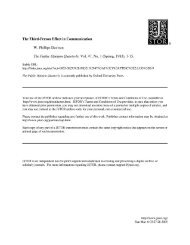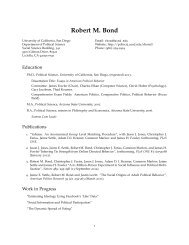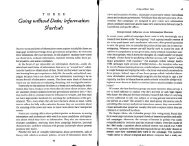Chapter 6 Why Authoritarian Parties? The Regime Party as an ...
Chapter 6 Why Authoritarian Parties? The Regime Party as an ...
Chapter 6 Why Authoritarian Parties? The Regime Party as an ...
Create successful ePaper yourself
Turn your PDF publications into a flip-book with our unique Google optimized e-Paper software.
CHAPTER 6<br />
Table 6.3: Restrictions on political parties <strong>an</strong>d the survival of authoritari<strong>an</strong> ruling coalitions,<br />
1946-2008<br />
Restrictions on At the beginning At the end<br />
<strong>Party</strong> Org<strong>an</strong>ization of a Ruling Coalition of a Ruling Coalition<br />
Medi<strong>an</strong> Me<strong>an</strong> N Medi<strong>an</strong> Me<strong>an</strong> N<br />
<strong>Parties</strong> b<strong>an</strong>ned 9 16.56 81 3 13.85 57<br />
(3,15) (12.33,20.78) (2,8) (8.63,19.08)<br />
Single party 27 29.87 51 22 25.08 49<br />
(20,35) (24.51,34.24) (15,30) (20.00,30.17)<br />
Multiple parties 8 15.91 195 10 17.90 223<br />
(7,10) (13.10,18.53) (8,13) (15.26,20.54)<br />
Note: <strong>The</strong> unit of observation is <strong>an</strong> authoritari<strong>an</strong> ruling coalition. 95% confidence intervals in<br />
parentheses. Largest ruling coalition durations are right-censored; me<strong>an</strong>s are therefore<br />
underestimated.<br />
Dopartiescontribute tothesurvival ofauthoritari<strong>an</strong>rulingcoalitions? Table6.3presents<br />
the estimated me<strong>an</strong> <strong>an</strong>d medi<strong>an</strong> survival times of ruling coalitions by the type of restriction<br />
on political parties. I list the 95% confidence interval below each estimated qu<strong>an</strong>tity in Table<br />
6.3. 29 Because restrictions on political parties may vary throughout the duration of a ruling<br />
coalition, I present estimates b<strong>as</strong>ed on the type of restrictions on political parties in place<br />
both at the beginning <strong>an</strong>d at the end of a ruling coalition’s existence. 30<br />
Table 6.3 indicates that ruling coalitions with single parties indeed survive between two<br />
<strong>an</strong>d three times longer th<strong>an</strong> either those without parties or those ruling coalitions that allow<br />
for the existence of multiple parties. We see that this difference is statistically signific<strong>an</strong>t <strong>as</strong><br />
there is almost no overlap between the 95% confidence intervals for the me<strong>an</strong> or the medi<strong>an</strong><br />
29 <strong>The</strong>se confidence intervals are calculated using the Kapl<strong>an</strong>-Meier estimator, accounting for the presence<br />
of right-censored data in the sample; see Klein <strong>an</strong>d Moeschberger (2003, chapter 4).<br />
30 We may directly account for the variation in restrictions on political parties by including this information<br />
<strong>as</strong> a covariate in a survival model. Estimates b<strong>as</strong>ed on both the Cox proportional hazard model <strong>an</strong>d<br />
parametric accelerated failure-time models lead to conclusions that identical to those discussed here.<br />
43











